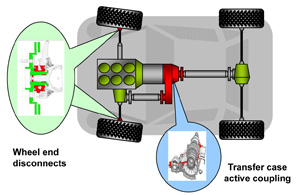
ROMEO, MI – Magna Powertrain expects increased demand for all-wheel-drive systems because of the feature’s popularity in Asia, as well as shifts in segmentation and architecture use.
Global Product Manager Walter Sackl points to Volkswagen AG as proof of Asia’s penchant for AWD.
The VW Tiguan cross/utility vehicle was expected to have a take-rate of 20% in China, but that number has swelled to 50%.
“Volkswagen, itself, was really astonished,” Sackl tells Ward’s. Magna supplies VW’s trademark 4Motion AWD system.
Asian-market demand for AWD also is strong in South Korea, he adds.
Worldwide, by 2015, Magna expects a 10% surge in the number of vehicles equipped with AWD, compared with 2009.
U.S. demand hiccupped last year, but a positive trend remains, according to Ward’s data.
![Magna system portends improved fuel economy.
<link rel="stylesheet" href="http://subscribers.wardsauto.com/galleries/files/lightbox.css" type="text/css" media="screen" />
<script src="http://subscribers.wardsauto.com/galleries/files/prototype.js" type="text/javascript"></script>
<script src="http://subscribers.wardsauto.com/galleries/files/scriptaculous.js?load=effects" type="text/javascript"></script>
<script src="http://subscribers.wardsauto.com/galleries/files/lightbox.js" type="text/javascript"></script>
<p><a href="http://subscribers.wardsauto.com/galleries/2010/Magna_AWD.jpg" rel="lightbox[plants]" title="Magna system portends improved fuel economy.">Enlarge Photo</a></p>](http://subscribers.wardsauto.com/images/2010/07/Magna_AWD.jpg)
The AWD installation rate for ’09 cars produced in North America was 3.9%, up from 3.2% in ’05 and 1.3% in ’01.
Some 9.6% of U.S.-market cars assembled overseas featured AWD in ’09, down from 10.5% in ’05, but up from 6.3% in ’01.
Against this backdrop, increasing consumer concern about fuel economy and the industry’s focus on carbon-dioxide emissions mandates continue to drive a vehicle-downsizing trend. Yet, consumers still favor the functionality they enjoyed in large SUVs.
For AWD suppliers, this represents an opportunity in “smaller-size vehicles that have the styling of SUVs,” Sackl says.
Former Magna International Inc. President Mark Hogan envisioned the same scenario during a 2006 interview with Ward’s.
Among the more prominent examples is the Mini Countryman, expected to debut later this year. The vehicle is a more muscular version of the Mini Cooper B-car and will feature AWD.
Magna Steyr Fahrzeugtechnik AG & Co KG will assemble the Countryman at its plant in Graz, Austria, but Magna Powertrain is not supplying the vehicle’s AWD system.
“The second growth area is a shift of architectures,” Sackl says, predicting a proliferation of vehicles featuring transverse-mounted engines.
Currently, architectures with longitudinally mounted engines represent 60% of the global mix, Sackl says, adding transverse setups are poised to dominate within three years because they afford packaging advantages that bring fuel-economy gains.
Increasing regulatory pressure to improve fuel economy and reduce CO2 emissions compelled Magna to develop an AWD system, dubbed Flex4, that deploys in 250 milliseconds when additional traction is needed, thereby reducing power loss.
Competitive systems already are in the market. “But they cannot do it with the seamless reconnect function,” Sackl claims. “(Deployment) takes more than one second.
“When you need safety, you need traction immediately,” he adds.
Sackl expects the system to go into production in 2013 with a volume of 500,000 units, but he is mum on details.



